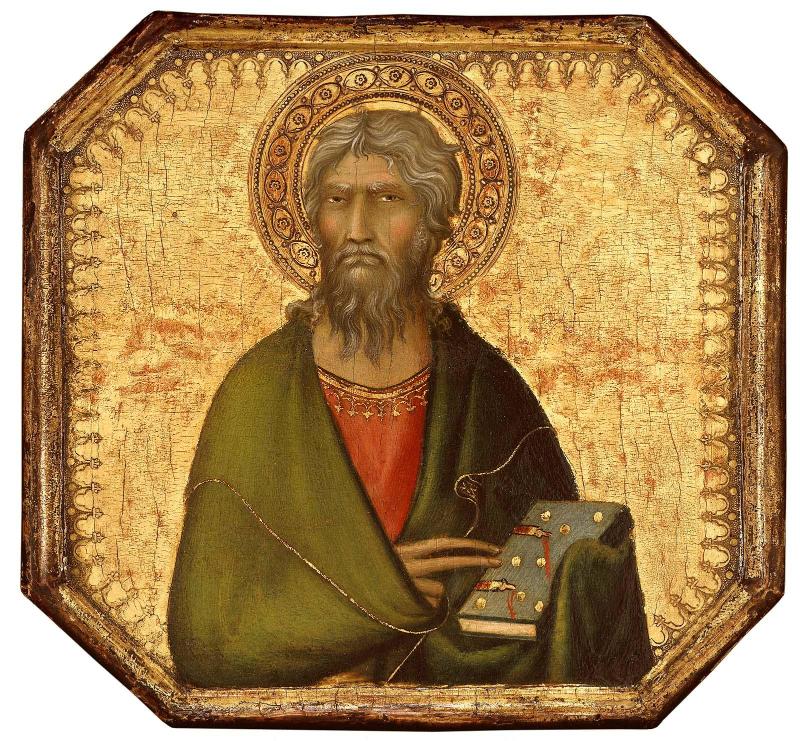Saint Andrew (?)
Simone Martini
(Italian (Sienese), about 1284–1344)
early 1320s
Medium/TechniqueTempera on panel
Dimensions18.4 x 19.7 cm (7 1/4 x 7 3/4 in.)
Credit LineCharles Potter Kling Fund
Accession number51.2397
On View
Not on viewClassificationsPaintings
Collections
The extraordinary elegance of this saint's hair and beard and the animated, serpentine line of the gold edge of his robe are proof that Martini was the greatest painter to emerge from the workshop of Duccio and among the most influential artists in Europe in the fourteenth century. This panel, possibly from a church in Orvieto, originally was part of a predella, a horizontal group of images at the bottom of an altarpiece.
ProvenanceEarly 1320s, possibly part of the predella of the altarpiece of S. Domenico, Orvieto [see note 1]. 1850, possibly Raffale Giannini and Luigi Rossini (b. 1790 - d. 1857), Palazzo Corsini, Rome [see note 2]. 1929, with Paul Bottenwieser (dealer; b. 1891 - d. 1942), Berlin and London [see note 3]. 1929, Morton H. Meinhard (b. 1872 - d. 1931), New York and Greenwich, CT; by descent to his widow, Carrie W. Meinhard (b. 1874 - d. 1951), New York and Greenwich; May 4-5, 1951, Meinhard estate sale, Parke-Bernet, New York, lot 305, sold for $6,500 to Julius Weitzner (dealer), New York; 1951, sold by Weitzner to the MFA for $15,000. (Accession Date: October 11, 1951)
NOTES:
[1] It has been suggested that this painting and another octagonal panel depicting a saint by Simone Martini (Birmingham, City Museum and Art Gallery) were panels in the predella of the artist's altarpiece at S. Domenico. This altarpiece was evidently removed to Paris during the Napoleonic Wars and returned to Italy about 1815. It was probably dismantled around this time. See Andrew Martindale, Simone Martini (New York, 1988), pp. 32, 185-186, 196-197, cats. 9,10, and 18.
[2] It is possible, but by no means certain, that this is one of three octagonal panels depicting apostles described as being in the style of Simone Martini, recorded in an 1850 inventory of the belongings of Raffaele Giannini and Luigi Rossini at the Palazzo Corsini, Rome ("Tre ottagoni in tavola, rappresentanti Apostoli. Maniera di Simon Memmi"). See Getty Provenance Index online, Archival Inventory I-248, item 2.
[3] The back of an old photograph of the painting (provided to the MFA by Carmen Gronau of Sotheby's, probably around the time of acquisition) records that it was taken in London in 1929, at which time the painting was with the dealer Bottenwieser. It was also published in 1929 as having been in Berlin until "recently" ("fino a poco tempo fa"), and at that time was in the Meinhard collection; see Raimond van Marle, "Quadri senesi sconosciuti," La Diana: Rassegna d'Arte e Vita Senese 4 (1929): p.308, pl. 4.
NOTES:
[1] It has been suggested that this painting and another octagonal panel depicting a saint by Simone Martini (Birmingham, City Museum and Art Gallery) were panels in the predella of the artist's altarpiece at S. Domenico. This altarpiece was evidently removed to Paris during the Napoleonic Wars and returned to Italy about 1815. It was probably dismantled around this time. See Andrew Martindale, Simone Martini (New York, 1988), pp. 32, 185-186, 196-197, cats. 9,10, and 18.
[2] It is possible, but by no means certain, that this is one of three octagonal panels depicting apostles described as being in the style of Simone Martini, recorded in an 1850 inventory of the belongings of Raffaele Giannini and Luigi Rossini at the Palazzo Corsini, Rome ("Tre ottagoni in tavola, rappresentanti Apostoli. Maniera di Simon Memmi"). See Getty Provenance Index online, Archival Inventory I-248, item 2.
[3] The back of an old photograph of the painting (provided to the MFA by Carmen Gronau of Sotheby's, probably around the time of acquisition) records that it was taken in London in 1929, at which time the painting was with the dealer Bottenwieser. It was also published in 1929 as having been in Berlin until "recently" ("fino a poco tempo fa"), and at that time was in the Meinhard collection; see Raimond van Marle, "Quadri senesi sconosciuti," La Diana: Rassegna d'Arte e Vita Senese 4 (1929): p.308, pl. 4.
Francesco di Giorgio Martini
about 1469–72
Unidentified artist, Russian (Palekh School), 18th century
Unidentified artist, Greek (Veneto-Cretan), 16th century
Argonaut Master
last third of the 15th century
Master of the Bracciolini Chapel
1420s













